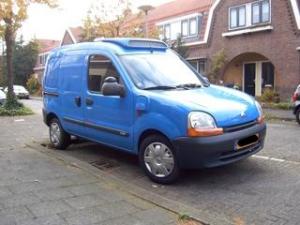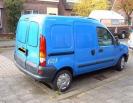| Owner | Miguel Agerkop | ||||||
|---|---|---|---|---|---|---|---|
| Owner's Other EV | 2014 BMW i3 | ||||||
| Location | Utrecht, Utrecht Netherlands map | ||||||
| Vehicle | 2002 Renault Kangoo Electri'cite | ||||||
| Motor | Leroy Somer Synchronous AC 3 pole About 15kW continuous, 30kW peak Aircooled Brake recuperation is very effective Max torque up to 50km/h: 165Nm | ||||||
| Drivetrain | Single ratio 8.02:1 | ||||||
| Controller | ACTIA Aircooled | ||||||
| Batteries | 22 Saft STM-100, 6.00 Volt, Nickel-Cadmium, Flooded The batteries have been replaced by Renault in 2008 during a callback event. They are in good shape, but haven't been in use for more than one year, so they needed some reconditioning. Update February 2015: The Nicad pack has been replaced with a lithium pack with 160v system voltage. | ||||||
| System Voltage | 132 Volts | ||||||
| Charger | Embedded Part of the Actia | ||||||
| Heater | Electrical | ||||||
| DC/DC Converter | Embedded Part of the Actia | ||||||
| Instrumentation | The usual, but no bms monitoring, only capacity and expected km's range. The dash looks sophisticated and is just like a gasguzzler's dash exept for the funny electrical meters. It has a PRND shiftstick that works fine. Update February 2015: SOC is now monitored via a smartphone using bluetooth and an app from EMUS. | ||||||
| Top Speed | 70 MPH (112 KPH) I did not test the topspeed yet, but 110 km/h should be doable. | ||||||
| Acceleration | After removing the refrigerator, it is pretty quick up to 60km/h. After that you need some patience to get to it's topspeed. Renault claims 0-50km/h in 8.5 seconds but I think my Kangoo is quicker than that due to the lighter weight. | ||||||
| Range | 55 Miles (88 Kilometers) City driving range about 55 miles, highway driving is possible for 45 miles. That is enough for cruising the city and it's perimeter. I guess in summer I will have a somewhat bigger range due to higher temperatures. Update February 2015: Range with the lithium pack is now 160-200 km's (100-125 miles). | ||||||
| Watt Hours/Mile | 150 Wh/Mile | ||||||
| EV Miles |
| ||||||
| Seating Capacity | 2 adults | ||||||
| Curb Weight | 2,500 Pounds (1,136 Kilograms) About 1250 kgs. | ||||||
| Tires | 165x65x14 | ||||||
| Conversion Time | Factory built car Update February 2015: Building and swapping the battery pack, rewiring, adding a bms and charger took about 40 hours in a professional workshop. | ||||||
| Conversion Cost | 25.000 Euro new, with factory conversion to cooled delivery van 30.000 Euro. I bought the Kangoo as a used car at a great discount for the time, so I did not have to spend this incredible amount of money fortunately. Update February 2015: The conversion costs to a lithium battery pack, added BMS, new charger and all the paid labor done by a specialized company, was about 15.000 euro. The original Nicad battery pack is still in perfect condition, I will probably sell them or use them in an off-grid solar system. | ||||||
| October 2011: I bought this vehicle two weeks ago as a "refrigerator van". I removed the refrigerator casing from the back, but kept the cooling system to be used as airconditioning on hot days. The weight savings are remarkable, it is much peppier now, as it is completely empty in the back. Superleggera I should say... to quote Lamborghini ;-) My Kangoo is just a bareboned delivery van, so no fancy gizmo's here. In city cruising, it is pretty quick nevertheless. The center of gravity is very low due to the motor mounted low and the battery casings under the floor. It corners better than the stock version I guess. It drives very sophisticated and quiet with good trottle response and the "right" ev-noise. I think the Kangoo was the most mature car from the PSA-group/Renault Nicad variety, until the new electric Kangoo and Zoe arrived -among others. The servicability of the ACTIA is very poor unfortunately. If you have problems you are on your own, support from Renault has been suspended, although it is still possible to order parts (very expensive though). The car invites you to drive dynamically, but that will cost you some tyres... Update February 2015: I replaced the 13.2 kWh Nicad battery pack with 50 Synopoly 200Ah cells, after 27.000 km's. The total capacity is now 32 kWh, of which 26 kWh is usable. The weight of the batteries has not changed. It was a snug fit using the existing battery boxes. This means the real life range has gone up from 80-100 km's to 160-200 km's. No new electric minivan to date has this range ;-) The BMS is from EMUS and the charger is a TC-Charger 3.0 Kw. Charging time from empty to full has actually decreased, because the neccesary time to balance the nicad battery by "overcharging" does not apply anymore. Furthermore, there is no maintenance (watering) on the battery anymore and no memory effect, so I can charge the car regardless of SOC. I think this is a big improvement. The car operates very well with 160v nominal battery voltage, as there is much less voltage sag. Drawback is that the SOC meter on the dash does not work anymore. Now I use an app on my smartphone to monitor the SOC while driving, but it is not always neccesary due to the comfortable range. | |||||||
Copyright © 1997-2025 by Mike Chancey


